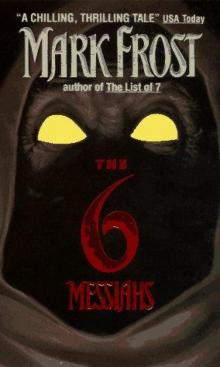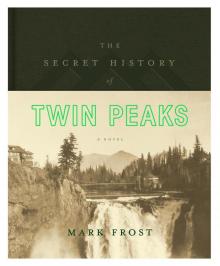- Home
- Mark Frost
Twin Peaks: The Final Dossier Page 2
Twin Peaks: The Final Dossier Read online
Page 2
The event in question appears to have happened on the same day as the explosion in the vault of Twin Peaks Savings and Loan, which, as you’ll remember from the dossier, resulted in the deaths of Pete Martell, Andrew Packard, and the bank’s assistant manager, Dell Mibbler. That evening, the incident’s only living survivor, Ben Horne’s eighteen-year-old daughter, Audrey, gravely injured in the explosion, was being treated in intensive care at Calhoun Memorial Hospital. A closer examination yielded the following nine curiosities, reported below.
First curiosity: Also being treated for a serious head injury in the same ER that same night was Audrey’s father, Ben Horne. Horne had spent most of the day in the hospital at Audrey’s bedside but apparently left sometime after dark, only to return—as an urgent care patient—a little over an hour later.
Second curiosity: The admitting physician—who, it turns out, also drove Ben Horne to the hospital after his injury—was Dr. Will Hayward. The injury, according to Hayward’s report, occurred at the Haywards’ home, the result of a fall suffered when Horne—quoting the hospital admittance form—“slipped on the hearth of the living room fireplace, hitting his head on the hard granite mantel.”
Hayward goes on to detail that Horne, despondent over his daughter’s condition, had come to the house “seeking counsel” about his daughter’s chances for recovery. (Why this conversation never took place at the hospital, where both men spent most of the day together, is neither asked nor answered.)
After rapidly consuming a couple of drinks, served by the doctor himself, Horne complained of feeling “light-headed” and, moments later, collapsed in front of the Hayward fireplace. The doctor goes on to mention that he and Horne had been speaking privately at the time, so there were no other witnesses.
Third curiosity: The only medical file I’ve been able to obtain from the hospital is brief, almost cursory, and was also written by Dr. Hayward. There is a reference to X-rays being taken, presumably to check for skull fractures—results negative—but I have been unable to find them. There is no mention of any other specific symptoms to support Dr. Hayward’s diagnosis that Ben Horne had suffered a “grade 2 concussion” and his recommendation that he be held in the hospital overnight for observation. Horne was admitted to a room just down the hallway from the one occupied by his injured daughter. With everything else going on in town that day—the bank explosion, Agent Cooper’s overnight disappearance and return—local law enforcement was stretched fairly thin, so it appears that no officials ever questioned the doctor’s account of Ben Horne’s injury.
Fourth curiosity: We now know that the next morning, Doc Hayward accompanied Sheriff Truman to examine Agent Cooper in his room at the Great Northern Hotel, after he returned from a mysterious night spent—exact whereabouts unknown—in the Ghostwood National Forest. While they were in the room—again according to Doc Hayward’s subsequent report—Agent Cooper went to the bathroom to brush his teeth, slipped on the bathroom floor, and slammed his head into the mirror over the sink, knocking himself unconscious. Once again, Doc Hayward accompanied his patient to the hospital—this time Sheriff Truman drove—and admitted him with the same diagnosis: a grade 2 concussion. While they were there, according to the hospital log timeline, Ben Horne was discharged—after being examined and cleared for release by the on-call doctor; not Doc Hayward—and was taken home by his brother, Jerry.
Fifth curiosity: Agent Cooper, according to available records, spent that day and night in the hospital before checking himself out—without receiving medical clearance—the following morning. Within two days, he would vanish from Twin Peaks and disappear from view for the next quarter of a century. We also know—from a report filed by Sheriff Frank Truman more than twenty-five years later—that at some point that day, while making his rounds, Doc Hayward saw Cooper in a hospital corridor, fully dressed in his usual black suit, exiting the room in the ICU occupied by Audrey Horne.
Sixth curiosity: Nine months later, almost to the day, Audrey Horne gave birth to her son Richard Horne. The birth certificate states the identity of the father as “unknown.”
Seventh curiosity: Within two days, Agent Cooper had vanished, and Major Garland Briggs—reportedly the last person in town whom Cooper visited before his disappearance—had been declared dead after a fire at Listening Post Alpha, high up in the mountains of the Ghostwood Forest. Although the charred corpse found at the scene was too damaged to identify through then relatively nascent DNA technology, the discovery of a few loose teeth, which matched Briggs’s dental records, led to the conclusion that he had indeed died in the fire, the cause of which, the subsequent intensive Bureau investigation concluded, remains “unknown.”
Eighth curiosity: Within three months of these apparently interrelated events, the following events occurred. After a lifetime spent in the state of Washington, without warning, Doc Hayward abruptly shuttered his thriving practice and moved all the way across the country to the town of Middlebury, Vermont. Shortly thereafter, Hayward and his wife, Eileen, after twenty-six years of marriage, filed papers that finalized an uncontested and mutually agreed-upon divorce. In that same month, their oldest daughter, Donna—just after graduating with honors from Twin Peaks High—also left town for good, settling in New York City. Her mother, still confined to a wheelchair after a car accident nearly two decades earlier, remained in the Hayward family’s Twin Peaks home, where she raised their two younger daughters, Harriet and Gersten, alone.
Ninth curiosity: I have identified a steady flow of income—$7,500 a month—into the bank account of Eileen Hayward. The payments began the month that Doc Hayward left town and persisted until Eileen’s death, from pneumonia, in 2009. These appear to have been direct-deposit wire transfers from an offshore account in the Cayman Islands. I have just traced that account to a shell LLC corporation registered to the Horne Foundation.
As of this writing, the foundation’s principal, Benjamin Horne—responding through his attorney—has denied my repeated requests for an interview on this subject. Since the filings were all made in accordance with existing law, and there is no apparent appearance of a crime or corporate malfeasance, DOJ has declined to issue a subpoena to pursue this matter.
My feeling—not entirely supported by fact—is that something untoward happened in the Hayward household that night when Benjamin Horne dropped in. The effects of this event seem to have devastated—and effectively destroyed—one of the community’s most admired and respected families. Harriet seems to have suffered the fewest ill effects; after high school, she studied at the University of Washington, eventually becoming a pediatrician in the Bellevue area, a suburb of Seattle. Gersten I’ll return to in a moment.
FEDERAL BUREAU OF INVESTIGATION Field Office Criminal Investigative and Administrative Files
Arriving in New York City in 1992, Donna Hayward began taking undergraduate classes at Hunter College. She had just turned eighteen. She supported herself by working as a model, eventually signing with the exclusive Ford modeling agency. All reports indicate that during this time she cut off all communication with both her father and her mother, exchanging letters and occasional phone calls only with her younger sisters. She similarly cut off contact with all of her former friends in Twin Peaks, with one exception: A few years later, she exchanged two letters with Audrey Horne. (I learned this from Donna herself, replying by written letter, not email, to my repeated inquiries to her. She was unwilling to share the letters with me, or discuss any of their content.)
As her modeling career advanced, Donna dropped out of Hunter College after her freshman year. The job carried her to various foreign countries, and she worked in Paris, Milan, Monaco, and other fashion meccas. Within the industry she was considered one of the “fresh faces” of the nineties—after the somewhat decadent previous decade—a return to a more wholesome all-American look, perhaps best epitomized by Kathy Ireland.
To be blunt, Donna had taken a hard left into the fast lane. During this time, she frequently
appeared in the gossip and society columns of various New York newspapers, where she was linked romantically with a variety of high-profile men: a soap opera star, a professional tennis player, a nightclub magnate, and a minor and somewhat dissolute scion of a European royal family.
Near the end of the decade, as she reached her late twenties and her modeling career slowed, Donna married a man nearly two decades her senior, the cofounder of a successful dot-com startup and a prominent figure in the New York venture capital community. If anything, this raised her social profile ever further, as the couple entertained frequently at their Sutton Place brownstone and their opulent beach house in Southampton.
Just before the turn of the century, at an unspecified charity event on one of these weekends, Donna apparently encountered Lana Budding Milford, the widow of Twin Peaks Post publisher Douglas Milford. Both wearing couture and wide smiles, their photo ran on the society page of the New York Post. While Lana appears to beam, on closer examination, something around the edges of Donna’s expression appears fraught with tension and dismay.
Whether this encounter had any direct bearing on what happened next is impossible to determine, but Donna’s fairy-tale New York existence—polo, yachts, helicopters, the whole nine yards of garish material excess—unraveled shortly thereafter, exposing the reality of a much harsher inner life: Four years into the marriage, Donna discreetly and, at first, voluntarily entered rehab for drug and alcohol dependence.
This proved to be only the first of Donna’s four stints in rehab over the next five years—the last of which, an involuntary stay at McLean psychiatric hospital, in Massachusetts, was the result of an intervention. This final episode—in which she was reported missing by her husband, then found two days later in a Lower East Side crack house—appears to have been triggered by the death from heart failure of her mother, Eileen, with whom Donna had never reconciled nor, as near as I can determine, spoken in the seventeen years since her sudden departure from Twin Peaks. Donna did not attend the funeral.
Shortly after her release from McLean, sober now but shaky, Donna’s husband initiated divorce proceedings. Because she had signed an ironclad prenuptial agreement, Donna was awarded only a low-six-figure lump sum and a modest monthly stipend. She soon moved into an apartment in a suburb of New Haven, Connecticut, far from the limelight in which she’d been living, where she rigorously attended local 12-step meetings and managed to hang on to her sobriety.
Approaching forty and facing an uncertain future, Donna at this point reached out to her father, Will Hayward, for the first time in more than twenty years. This contact, it seems, led to their reconciliation. Within a year, Donna had moved to the small college town of Middlebury, Vermont, where Will—now well into his seventies—was still practicing family medicine. Donna moved in with her father and began working as his assistant in his practice. Doc Hayward, in the past year, has quietly begun to wind down his daily hours but says he intends to never fully retire. Donna remains by his side to this day, living a quiet life and very active as a sponsor in the local 12-step community. Although she politely rebuffed all of my attempts to speak to her directly, I’ve learned she is currently studying to obtain a degree as a nurse practitioner.
I should mention that Donna’s youngest sister, Gersten, has, if anything, suffered even more obvious ill effects from whatever events tore this family apart. Gersten was an exceptional child in many regards; a musical prodigy, she performed as a piano soloist in concert venues all across the Northwest while still in her early teens. She was also a prodigiously talented mathematician, taking college-level courses while still a high school freshman; she graduated from high school at sixteen and was offered scholarships from a number of prominent universities. Able to speak and read four languages fluently, Gersten has been tested well above genius level in IQ.
Throughout her childhood and teen years, her exceptionalism in so many disciplines appeared to function as a kind of shield from the turbulence and unhappiness that descended on her family. Once she entered Stanford University, at sixteen, however, it quickly became apparent that the energy put into all of these high-stress/high-function abilities did not protect her from whatever trauma she’d suffered as a child, nor did it prepare her emotionally for the internal demands this more adult world was now placing on her. By the middle of her second semester, after exhibiting alarming symptoms of maladaptation to her new circumstances, Gersten suffered what was diagnosed as a severe nervous collapse and emotional breakdown.
After six weeks of treatment in a Bay Area psychiatric hospital, she was released, withdrew from Stanford, and returned home to Twin Peaks to live with her mother. Gersten underwent immediate and ongoing psychiatric care, and her health improved, but sadly, her ability to cope with the trials of everyday living did not. Although doctors had prescribed for her a steady course of antidepressants as an ongoing protocol, during this period Gersten privately turned to stronger street drugs for comfort, concurrent with the nationwide trend in dependence on opioids and designer synthetics. The death of her mother, Eileen, in 2009, by removing her protective influence and the social safety net Gersten had come to depend upon, appeared to derange her even further. This led her into a series of reckless and chaotic relationships with a number of men and women. The most damaging of these proved to be an off-again, on-again affair with one Steven Burnett, an unstable career miscreant and low-level drug dealer in the Twin Peaks area, who had in the interim become her primary source for narcotics.
This relationship preceded and apparently also overlapped Steven’s marriage to Rebecca Briggs, daughter of Shelly and Bobby Briggs. Now in her early twenties, Becky works at a bakery owned by Norma Jennings in downtown Twin Peaks. A warrant for Steven Burnett was recently issued as a suspected accomplice in an international drug-running operation—he has gone missing—that prominently involved Audrey’s son, Richard Horne—who is also still at large and wanted on, among other things, a hit-and-run warrant—and a crooked deputy in the Twin Peaks Sheriff’s Department, Chad Broxford, who is currently awaiting trial on a variety of charges. The timely intervention of her mother, Shelly, and her father, Deputy Sheriff Bobby Briggs, appears to have spared Becky any lasting legal trouble, but Gersten has not been seen since and is believed to have left the area.
FEDERAL BUREAU OF INVESTIGATION Field Office Criminal Investigative and Administrative Files
Nothing would please my longing for narrative closure more than to report that Audrey Horne’s near-death experience at the bank resulted in a meaningful reconciliation with her father, Ben. Sadly, this does not appear to be the case. The unknown seismic shifts that led to the dissolution of the Hayward marriage appeared to cause a kind of bank-shot collateral damage to the Hornes’ thirty-year union as well. Having already lived separate lives, by most accounts, for more than a decade, Ben and Sylvia Horne divorced within two years of the Haywards’ dissolution. Both remained in the Twin Peaks area: Ben kept the old family house, and Sylvia moved across town to a McMansion in a gated, upscale housing development where she has ever since assumed sole custody and care of their special-needs son, Johnny—a profound case of autism—who is now in his early forties.
Audrey awoke from the coma she’d been in as a result of the bank explosion after three and a half weeks. She apparently retained no memory of the event itself, and at first seemed to be on her way to a complete recovery. Two events altered that trajectory. First was her father’s decision to proceed with the sale of the Horne family’s privately owned 350-acre parcel of the Ghostwood Forest—the sale Audrey had been protesting against when she went into the bank that morning—to a secretive investment capital group that immediately began construction of a privately owned and operated state prison on the site. Then Audrey discovered, two months after her release from the hospital, that she was pregnant.
Audrey refused all offers of financial help from her father and mother, moved out of the family home and into a small apartment, and prepared, as she put it
in a letter to her mother at the time, for the most important role of her life: raising her child as a single mother. Audrey had just turned nineteen when her son, Richard, was born. She never returned to high school, completing her GED through independent study over the next two years. She then enrolled in classes at the local community college, studying economics and business administration.
After obtaining her degree, she opened a local hair and beauty salon in the Twin Peaks area, which she has successfully owned and operated ever since. She had few friends, outside of her customers and employees, and largely kept to herself. She never commented publicly—and was never heard to speculate with anyone—about who the father of her son might be, and didn’t seem interested in discussing it with anyone. If Audrey herself was curious about the father’s identity, she never availed herself of any easily obtained paternity test that I’ve been able to uncover. One could conclude that she didn’t care, or perhaps she knew who it was all along. (The only possible clue I’ve been able to find along these lines is a framed photo of Agent Cooper that hangs on the wall of her office at the salon.)
True to her word, although her mother, Sylvia, played an important role as Richard’s grandmother, Audrey raised the boy entirely on her own. She has apparently never allowed her son to meet his grandfather Ben. Circumstances changed after Richard’s tenth birthday, when, without warning, in a private civil ceremony, Audrey married her longtime accountant. Witnesses close to the situation suggest that this was more a marriage of financial convenience than affection, and during my research here I’ve come across troubling accounts of public scenes, heavy drinking, verbal abuse, and sexual infidelity—all allegedly on the wife’s part. The couple briefly consulted a marriage counselor, and Audrey apparently consulted her own mental health care professional during this time, but those files are sealed and inaccessible. Four years ago, without warning, Audrey closed the salon. Not long after she seemed to vanish from public life, into either agorophobic seclusion, or—one troubling rumor suggests—a private care facility. The Horne family spokesperson has refused to respond to all inquiries regarding her whereabouts.

 Rogue
Rogue The Second Objective
The Second Objective Alliance
Alliance Twin Peaks: The Final Dossier
Twin Peaks: The Final Dossier The Paladin Prophecy
The Paladin Prophecy Game Six: Cincinnati, Boston, and the 1975 World Series: The Triumph of America's Pastime
Game Six: Cincinnati, Boston, and the 1975 World Series: The Triumph of America's Pastime The List of Seven
The List of Seven The Autobiography of FBI Special Agent Dale Cooper
The Autobiography of FBI Special Agent Dale Cooper The Six Messiahs
The Six Messiahs The Secret History of Twin Peaks
The Secret History of Twin Peaks Paladin Prophecy 2: Alliance
Paladin Prophecy 2: Alliance Game Six
Game Six